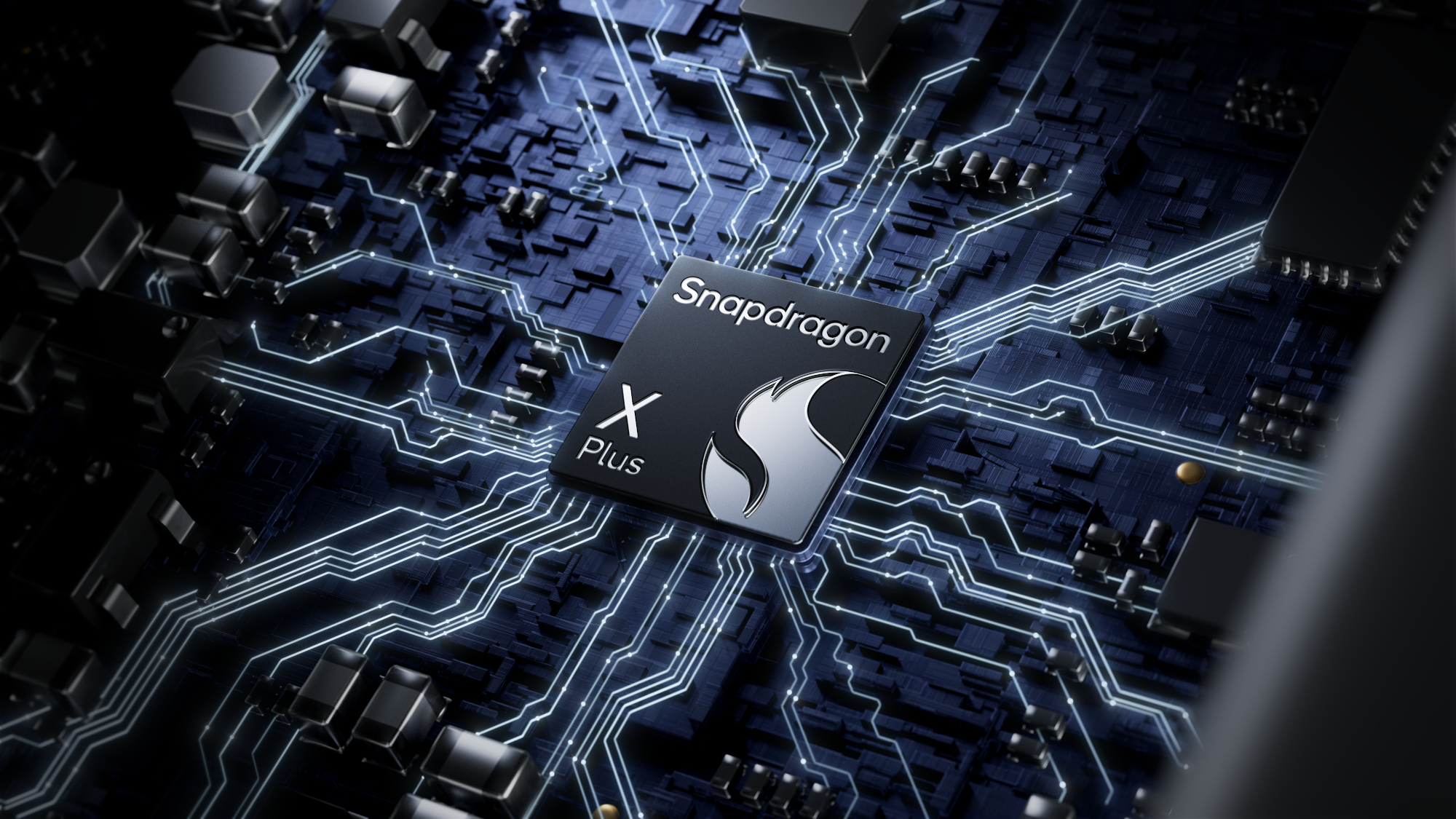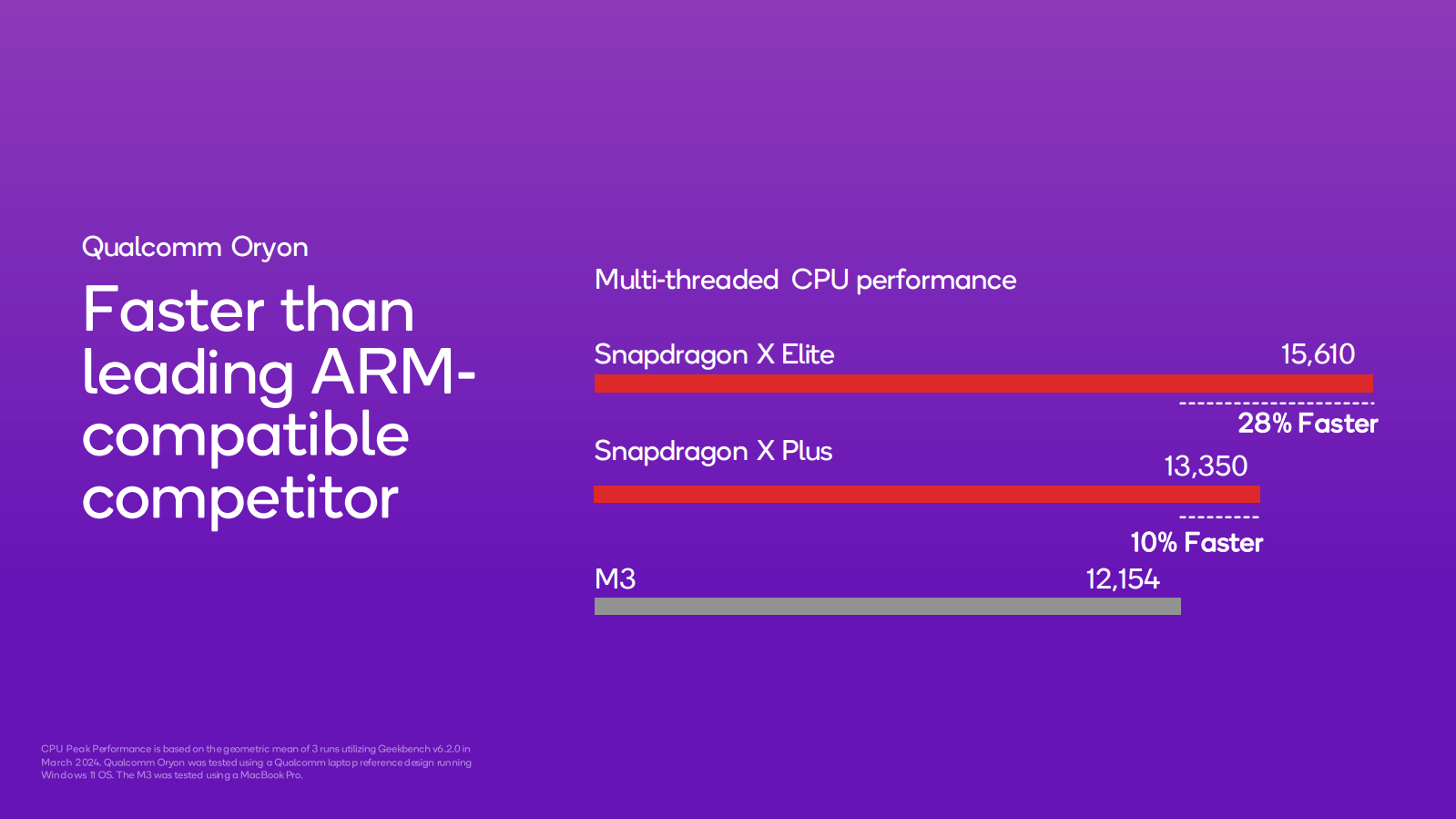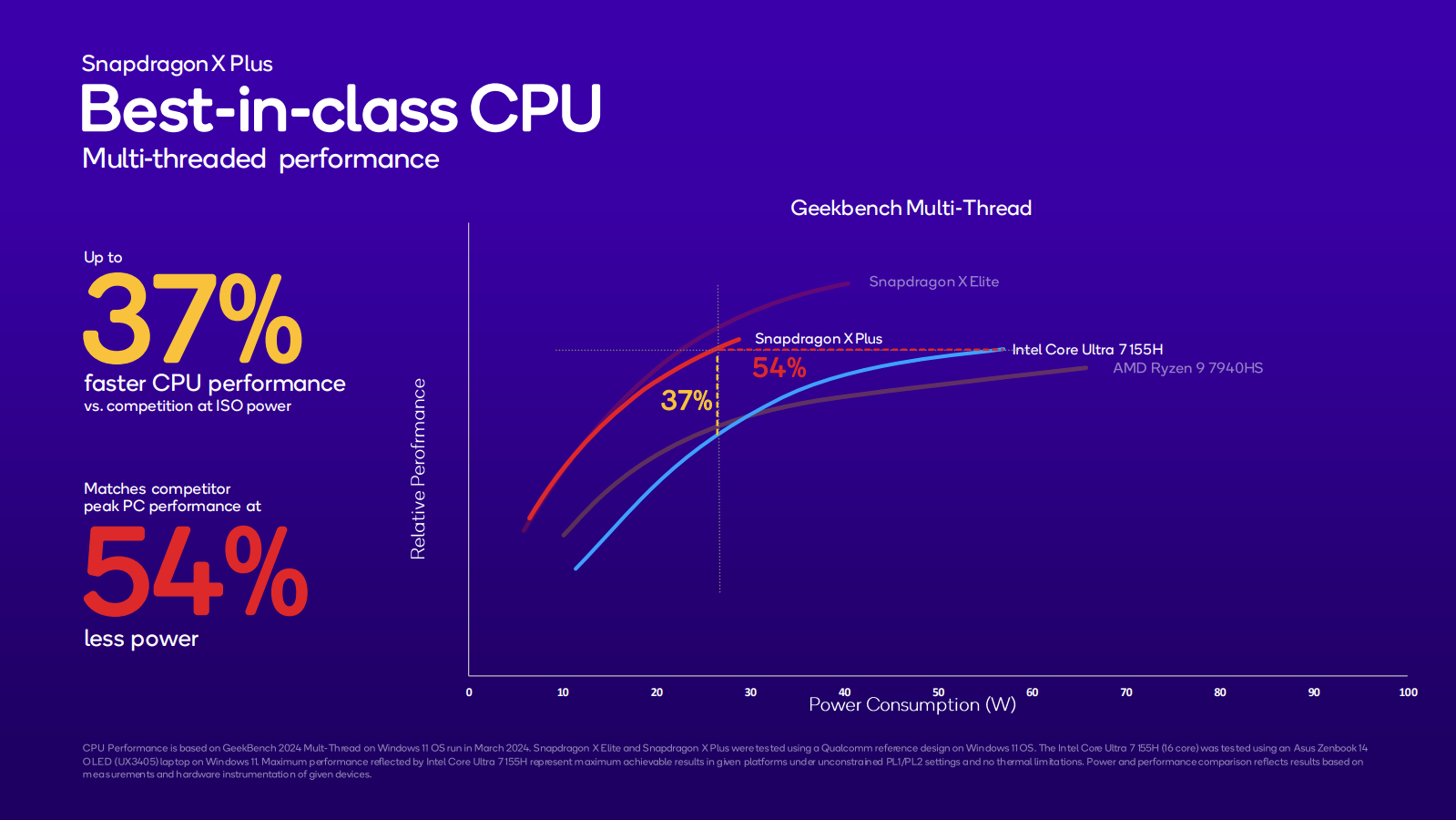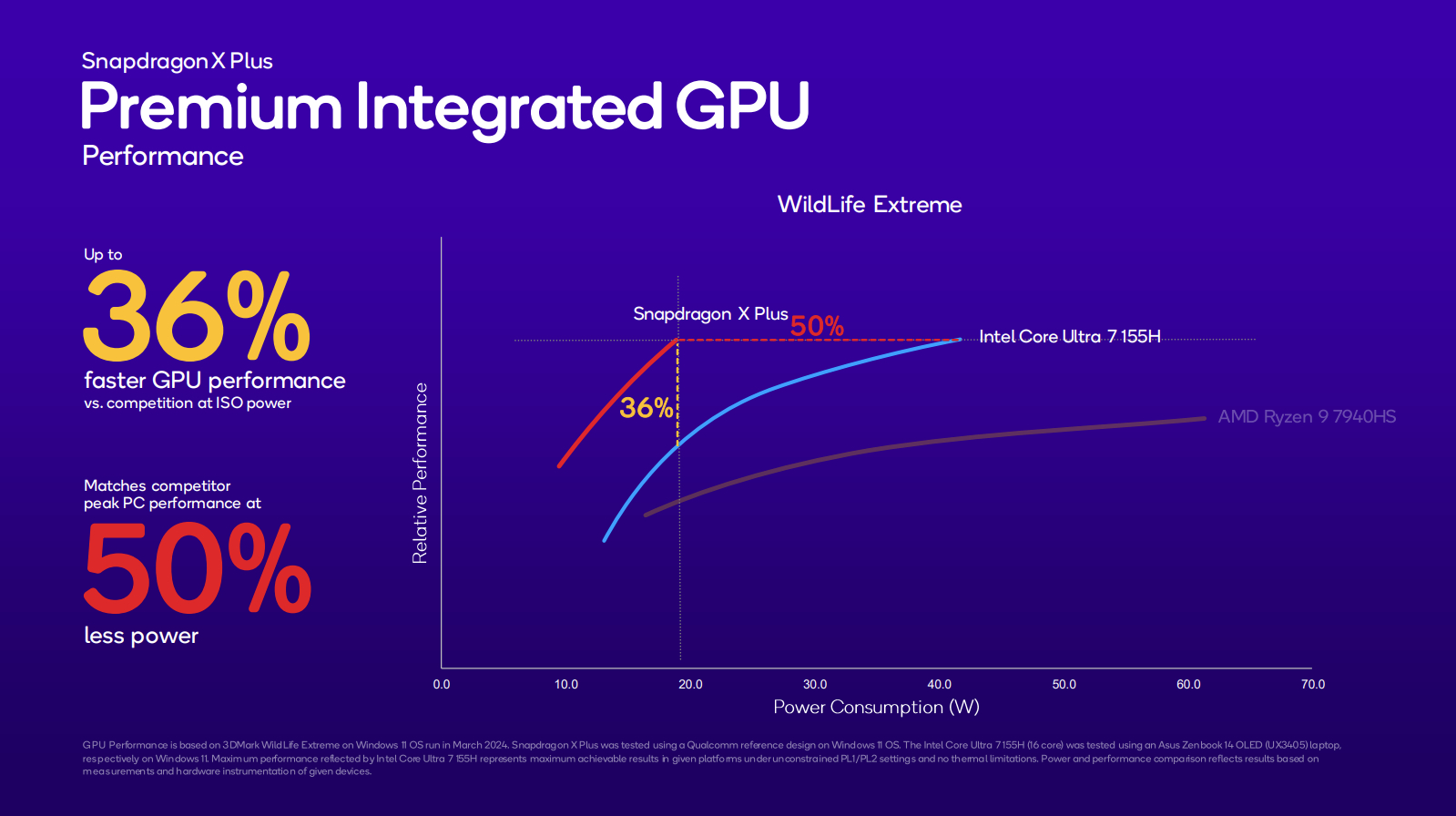Snapdragon X Plus — availability, AI features, specs and more

Qualcomm released its Snapdragon X Plus chip in mid-2024 alongside the more powerful Snapdragon X Elite processor. Like the X Elite, the Snapdragon X Plus chips feature the company’s custom-integrated Qualcomm Oryon CPU — which promises faster CPU performance than competing processors while consuming less power.
The inaugural Snapdragon X Plus chip packs a 10-core Qualcomm Oryon CPU and a 45 TOPS NPU, which Qualcomm says is the faster NPU for laptops. Because of that, the company claims the X Plus features “industry-leading on-device AI capabilities.” But as we know, Intel and AMD aren't far behind with their respective AI-focused processors.
One of the first laptops that utilized the Snapdragon X Plus chip is the Microsoft Surface Pro 11, but dozens have followed since. These AI-focused chips may not be quite as fast as their beefier siblings in the X Elite family, but the Snapdragon X Plus still gives competing processors like the Intel Core Ultra line and the Apple M3 a run for their money.
Plus, in September 2024 Qualcomm added a cheaper, less powerful Snapdragon X Plus chip to its lineup. The pitch is that this cheaper Snapdragon X Plus chip delivers big AI performance in laptops starting at $700, which is great for folks who want an inexpensive laptop with AI features, enough horsepower to get through day-to-day work and all-day battery life.
Here’s everything we know about Snapdragon X Plus.
Snapdragon X Plus: Availability
The first laptops featuring Snapdragon X Plus and Snapdragon X Elite chips started shipping in June 2024. As announced during the Microsoft Build 2024 Surface event, manufacturers like Acer, Asus, Lenovo and Microsoft released devices featuring Snapdragon X processors.
Prices for these initial Snapdragon X laptops started at $999, depending on the vendor. Since then we've seen laptops launching with Snapdragon X chips at various prices.
Get instant access to breaking news, the hottest reviews, great deals and helpful tips.
Snapdragon X Plus: Specs and performance

The Snapdragon X Plus is built on the same 4nm process as the Snapdragon X Elite and the Snapdragon 8 Gen 3 for mobile devices. This chip features 10 high-performance cores capable of hitting 3.4GHz. Its CPU memory architecture has up to 135GB/s of bandwidth and 42MB total cache.

Qualcomm says the X Plus is up to 10% faster than the Apple M3 chip and 54% faster than the Intel Core Ultra 7 155H CPU in the Geekbench multi-threaded CPU performance. The company also says its chip consumes 54% less power than Intel’s processor in the same benchmark test.
In the 3DMark Wildlife Extreme graphics benchmark, the Snapdragon X Plus’ Adreno GPU is 36% faster than the Intel Core Ultra 7 155H and consumes half as much power. Based on that, X Plus’ integrated GPU offers superior graphical performance over Meteor Lake’s Xe Graphics.
Like X Elite, Snapdragon X Plus supports 4K displays at 120Hz and HDR10. It also supports triple UHD (4K) and dual 5K, both at 60Hz. If you have a multi-monitor setup or want one, laptops packing Qualcomm’s CPU is up to the task.
Snapdragon X Plus: Our testing
We had a few opportunities to test the Snapdragon X Plus' performance in the Geekbench 6 CPU benchmark test during press events in 2024.
| Chip (laptop) | Geekbench 6 (single-core) | Geekbench 6 (multicore) |
|---|---|---|
| Qualcomm Snapdragon X Plus (Reference design laptop) | 2408 | 13015 |
| Qualcomm Snapdragon X Elite (Reference design laptop) | 2864 | 15016 |
| M3 (MacBook Air) | 3082 | 12087 |
| M3 Pro (MacBook Pro) | 3154 | 14357 |
| M3 Max (MacBook Pro) | 3200 | 21711 |
| Intel Core Ultra 7 155H (Asus Zenbook Duo) | 2475 | 12867 |
| Intel Core Ultra 9 185H (Samsung Galaxy Book 4 Ultra) | 2421 | 13124 |
We also tested the weaker 8-core Snapdragon X Plus chips that Qualcomm launched at IFA 2024 in September, and our results reveal they're not too far behind the inaugural 10-core Snapdragon X Plus chip.
As you can see from the chart of results below, these two 8-core Snapdragon X Plus chips (memorably named X1P-46-100 and X1P-42-100) can't outpace their beefier siblings or Apple's M3 chip—but they still have an edge over stronger Intel chips from the previous generation, at least in single-core performance.
| Chip | Geekbench 6 single-core | Geekbench 6 multicore |
|---|---|---|
| Snapdragon X Plus 8-core X1P-46-100 | 2780 - 2813 | 11713 - 12001 |
| Snapdragon X Plus 8-core X1P-42-100 | 2385 - 2445 | 11027 - 11530 |
| Apple M3 MacBook Air | 3082 | 12087 |
Multi-core performance for all the Snapdragon X Plus chips is a little closer to the competition, though the powerful M3 Pro and M3 Max run circles around the lower-end Snapdragon X Plus. However, Qualcomm's chip is faster than the M3 found in the latest MacBook Air and iMac.
X Plus wants to be the mid-tier Windows laptop market, with numbers much closer in competition to the Intel Core Ultra 7 155H in the Asus Zenbook Duo. However, the Ultra 9 185H in the Samsung Galaxy Book 4 Ultra has the advantage.
Snapdragon X Plus: Qualcomm AI engine
Like the Snapdragon X Elite chip, the Snapdragon X Plus is made to handle AI-driven tasks more efficiently than a standard CPU or GPU. To that end, it’s also a direct competitor to Intel’s Meteor Lake and Apple’s M3.
Snapdragon X Plus’ AI Engine runs on an upgraded Hexagon NPU that’s capable of 45 TOPS (trillion operations per second). While that’s less than the X Elite’s 75 TOPS, it’s more than Meteor Lake’s 34 TOPS. Laptops featuring the X Plus (and X Elite) can crunch through AI-driven tasks without obliterating your laptop’s battery.
Snapdragon X Plus: Outlook
Qualcomm talked a big game about its Snapdragon X chips. Based on our testing and hands-on experience, laptops featuring this processor do indeed deliver excellent performance and incredible battery life. The AI capabilities haven't yet been fully realized, but this is also something Intel and AMD have yet to crack. Regardless, we're impressed by the performance and endurance of machines packing Qualcomm's chip.
As for the Snapdragon X Plus chip, its lower comparative specs to X Elite suit lower-priced laptops like the Dell Inspiron 14 Plus well. To that end, you have a choice between two AI-driven Qualcomm PC processors, which is certainly nice.
More from Tom's Guide
- Snapdragon X Elite could crush Intel chips in laptops
- Google Chrome is coming native to Snapdragon X Elite laptops
- Snapdragon X Elite laptops could have an advantage over MacBooks

Tony is a computing writer at Tom’s Guide covering laptops, tablets, Windows, and iOS. During his off-hours, Tony enjoys reading comic books, playing video games, reading speculative fiction novels, and spending too much time on X/Twitter. His non-nerdy pursuits involve attending Hard Rock/Heavy Metal concerts and going to NYC bars with friends and colleagues. His work has appeared in publications such as Laptop Mag, PC Mag, and various independent gaming sites.










